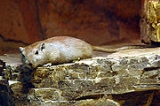
Sand Rat
Encyclopedia
The sand rat also known as the fat sand rat, is a terrestrial mammal
from the gerbil
subfamily that is mostly found in North Africa and the Middle East
, ranging from Mauritania
to the Arabian Peninsula
.
family.
The sand rat is diurnal, but its activity on the surface depends on the ambient temperature.
The sand rat normally has two litters every year, each litter usually ranges between three to seven pups.
when they are fed a normal rodent diet of grains. Therefore they have been used as an animal model for studies on diabetes. Because they are diurnal, they are also used as models for human seasonal affective disorder
.
The presence of sand rats in North Africa and the Middle East is of healthcare importance, as this species can harbor the parasite
which causes leishmaniasis
in humans.
These animals have been studied extensively for their remarkably efficient kidneys: they can produce very concentrated urine which enables them to eat halophyte
plants and survive extreme heat and lack of water in their desert habitat.
Mammal
Mammals are members of a class of air-breathing vertebrate animals characterised by the possession of endothermy, hair, three middle ear bones, and mammary glands functional in mothers with young...
from the gerbil
Gerbil
A gerbil is a small mammal of the order Rodentia. Once known simply as "desert rats", the gerbil subfamily includes about 110 species of African, Indian, and Asian rodents, including sand rats and jirds, all of which are adapted to arid habitats...
subfamily that is mostly found in North Africa and the Middle East
Middle East
The Middle East is a region that encompasses Western Asia and Northern Africa. It is often used as a synonym for Near East, in opposition to Far East...
, ranging from Mauritania
Mauritania
Mauritania is a country in the Maghreb and West Africa. It is bordered by the Atlantic Ocean in the west, by Western Sahara in the north, by Algeria in the northeast, by Mali in the east and southeast, and by Senegal in the southwest...
to the Arabian Peninsula
Arabian Peninsula
The Arabian Peninsula is a land mass situated north-east of Africa. Also known as Arabia or the Arabian subcontinent, it is the world's largest peninsula and covers 3,237,500 km2...
.
Habitat, behavior and food habits
This species usually lives in sandy deserts, but may also be found in rocky terrain or saline-marsh areas. It lives in burrows, which are often located under the bushes in which the rats forage, such as salt bushes of the ChenopodiaceaeChenopodiaceae
Chenopodiaceae were a family of flowering plants, also called the Goosefoot Family. They are now included within family Amaranthaceae. The vast majority of Chenopods are weeds, and many are salt and drought tolerant. A few food crops also belong to the family: spinach, beets, chard, quinoa, and...
family.
The sand rat is diurnal, but its activity on the surface depends on the ambient temperature.
The sand rat normally has two litters every year, each litter usually ranges between three to seven pups.
Medical significance
Sand rats can easily acquire diabetes mellitusDiabetes mellitus
Diabetes mellitus, often simply referred to as diabetes, is a group of metabolic diseases in which a person has high blood sugar, either because the body does not produce enough insulin, or because cells do not respond to the insulin that is produced...
when they are fed a normal rodent diet of grains. Therefore they have been used as an animal model for studies on diabetes. Because they are diurnal, they are also used as models for human seasonal affective disorder
Seasonal affective disorder
Seasonal affective disorder , also known as winter depression, winter blues, summer depression, summer blues, or seasonal depression, is a mood disorder in which people who have normal mental health throughout most of the year experience depressive symptoms in the winter or summer, spring or autumn...
.
The presence of sand rats in North Africa and the Middle East is of healthcare importance, as this species can harbor the parasite
Leishmania major
Leishmania major is a species of Leishmania.It is associated with zoonotic cutaneous leishmaniasis.The genome has been sequenced....
which causes leishmaniasis
Leishmaniasis
Leishmaniasis is a disease caused by protozoan parasites that belong to the genus Leishmania and is transmitted by the bite of certain species of sand fly...
in humans.
These animals have been studied extensively for their remarkably efficient kidneys: they can produce very concentrated urine which enables them to eat halophyte
Halophyte
A halophyte is a plant that grows where it is affected by salinity in the root area or by salt spray, such as in saline semi-deserts, mangrove swamps, marshes and sloughs, and seashores. An example of a halophyte is the salt marsh grass Spartina alterniflora . Relatively few plant species are...
plants and survive extreme heat and lack of water in their desert habitat.

